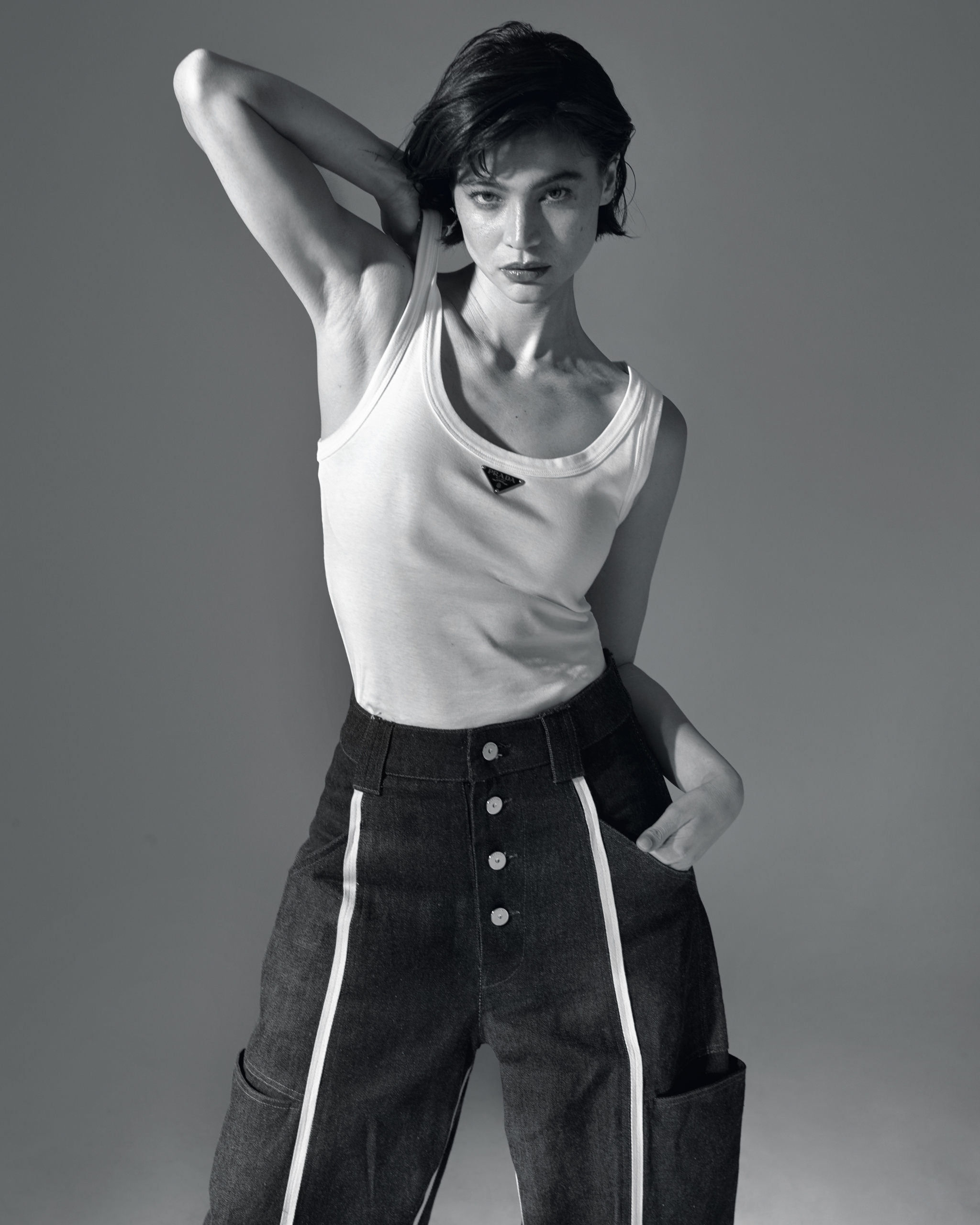PRADA tank top, BAGASÁO banana cargo trousers. Mark Nicdao.
Classic pieces reign supreme for Anne Curtis in Vogue Philippines’ December cover shoot.
Multifaceted media muse Anne Curtis is in the full flush of her influence—a bona fide celebrity, actress, and entrepreneur.
It’s her approach to life that makes people want to follow her. Curtis is someone who strongly believes in embracing one’s roots.
“Jumping off from our ongoing dialogue on Filipino identity and its many representations in the diaspora, Anne is someone who has navigated [throughout life] by celebrating her bicultural background equally,” Vogue Philippines’ fashion director Pam Quiñones says. By honing on an authentic voice and an honest point of view, she has garnered a substantial following. The concept behind the shoot of her cover story, “Age of Influence,” incorporated a new direction of tastemaking by translating what is classic into new contexts.
“We wanted to have an influential modern persona wearing something that is rooted in our history (like the terno) in an unfamiliar environment,” explains Quiñones. By taking something that’s rooted in our Filipino identity and presenting it in a modern environment, we move towards stylish, unchartered territory that ushers in the future.
Vogue Philippines fashion associate Renee De Guzman adds that they “wanted to really focus on the story behind [the cover shoot by] celebrating Anne and how timeless she is.”
This “new classics” inspiration is seen throughout the spread. Curtis wears a Kelvin Morales Phalaenopsis modern barong paired with Strongvillage patchwork elephant trousers.
“We [paired the] Strongvillage [trousers] with a really cool, almost streetwear barong which is a modern take on our national costume,” Quiñones says. “We wanted to juxtapose the whole shoot with something masculine, [yet something] that also felt right for a woman to wear.”
Curtis also wore a floor-grazing Bon Hansen Reyes balintawak in a dark grey hue with deconstructed sleeve elements attached to the distinguishable and timeless butterfly sleeves.
“This particular piece is special because it showcases how a traditional terno can be [assimilated] into modern times,” says De Guzman. The alampay was made into a sleeve and connected to the garment effortlessly. “The modernized terno is a product of different cultures. The terno sleeves (its 3D composition and construction) were inspired heavily by Western fashion in the 1900s,” remarks Quinones.
“It’s a microcosm of what is happening in the Filipino fashion industry.”
By acknowledging this history, the terno is recontextualized into modern settings. This Bon Hansen Reyes dress has Japanese sensibilities, yet comprises distinctly Filipino features. “Something as traditional as the terno [becomes] a product of cross-cultural hybridity,” Quiñones says.
Curtis wears a Prada tank top paired with Bagasáo banana cargo trousers.
“[With this tank top], we wanted to add a sense of simplicity, something ubiquitous yet unusual, edgy, and of-the-moment,” says Quiñones. By capturing Curtis in a laid back manner, it lent to an air of contemporaneity. By injecting a designer Italian brand into a simplistic ensemble, the shoot alludes to its international influences.
For the denim trousers, designer Seph Bagasao references the craft and custom pieces his grandmother wore. A designer that is inspired by both his hometown in Nueva Ecija and his travels, a mix of Filipino sensibilities and Japanese design elements can be found in the garment.
“It’s a microcosm of what is happening in the Filipino fashion industry,” Quiñones elaborates. Nowadays, Filipino designers are incorporating influences from both the East and the West signaling a new era.
“Overall, the pieces chosen for this particular shoot touches [on] different types of craftsmanship ranging from upcycling garments to embroidery to [Filipino] textiles [and] denim [demonstrating the evolution] of Filipiniana. That’s something we really wanted to encapsulate through this cover story,” says De Guzman. The “Age of Influence” is a celebration of many stories with Filipino identity at its core. “We are going into our roots and telling the stories of Filipino creatives [through reimagining] traditional dress,” concludes Quiñones.
What “Age of Influence” really embodies is hyperlocalization and delving deeper within our origins. It’s a celebration of an individual who can pay tribute to her bicultural identity.
What Curtis asserts is that the Filipino identity spans more than just being a Filipino and living in the Philippines. To be Filipino is to embrace the Filipino experience regardless of one’s blood. To be Filipino means to wholeheartedly embrace your roots.
Vogue Philippines’ December-January 2023 Issue is out now. Subscribe here.
Photography: Mark Nicdao, Fashion Director: Pam Quiñones, Stylist: Renee De Guzman, Makeup: Robbie Piñera, Hair: Raymond Santiago, Nails: Extraordinail, Art Director: Jann Pascua, Producer: Anz Hizon, Production Assistant: Adam Pereyra, Photographer’s Assistant: Phillip Nicdao, Arsan Hofileña, Alex Capongcol, Crisaldo Soco, Villie James Bautista, Stylist’s Assistant: Steven Coralde, Special thanks to Justine Arcega-Bumanlag, Garden Barn Inc. and Umbra



